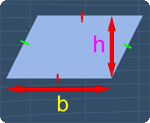Area of a Parallelogram
Lesson Objective
In this lesson, we will learn about the area of a parallelogram.
About This Lesson
In this lesson, we will:
- Learn about the formula for the area of a parallelogram.
- See an example on using the formula to find a parallelogram's area.
- See another example on using the formula to calculate the height of a parallelogram.
The study tips and math video below will explain more.

Study Tips
Tip #1
A parallelogram has two pairs of parallel sides and its opposite sides are equal in length. These properties are shown on the right.
Now, if the parallelogram has the base b and the height h, the area, A, of the parallelogram will be:
The math video below will give more explanation on this. Also, we will see some examples on how to use this formula.


Math Video
Math Video Transcript
00:00:03.170
In this lesson, we will learn about the area of a parallelogram.
00:00:08.120
Consider this parallelogram with the base B and the height H.
00:00:14.190
Now, to find the area of this parallelogram, A, let's observe this parallelogram carefully.
00:00:22.060
If we cut out this portion and place it here. Observe that, we now have a rectangle.
00:00:30.150
Therefore, we can say that the area of this parallelogram is that same as, the area of this rectangle.
00:00:38.050
In the previous lesson, we learned that the area of a rectangle can be found by multiplying its length and width together.
00:00:46.240
Similarly, we can find this area, by multiplying the base, and height together. Hence, we have B multiply H which is the same as BH.
00:00:59.180
Let's change this back to a parallelogram. Now, the area of this parallelogram, A, equals to BH.
00:01:09.210
Note that, it is very important to include the unit. Since this is the formula for area, its unit will be in the form of square unit.
00:01:19.160
We will see more explanations on this, in the upcoming example.
00:01:25.020
Now, let's see some examples on using this formula.
00:01:29.220
Find the area of this parallelogram when its base is 5cm, and its height is 3cm.
00:01:37.110
To solve this, we start with the formula for the area of a parallelogram, A equals to BH.
00:01:44.240
Since the base is given as 5cm, we can substitute b with 5.
00:01:51.010
Similarly, since the height is given as 3cm, we can substitute h with 3.
00:01:57.240
Next, we can simplify by multiplying 5 with 3. This gives 15.
00:02:05.020
Note that, this number has no meaning unless we include the unit for it.
00:02:10.070
Since the units are given in centimeter, the unit for the area will be in square centimeter.
00:02:16.070
Hence, the area of this parallelogram is 15 square centimeter.
00:02:22.240
Next example, given that the area of this parallelogram is 20 square feet, and its base is 4ft. Find its height.
00:02:32.130
Again, we start with the formula for the area of a parallelogram, A equals to BH.
00:02:39.190
Now, since the area, and the base are given, we can find the height by solving this equation for H. Here’s how.
00:02:48.210
Since the area is given as 20 square feet, we can substitute A with 20.
00:02:54.210
Similarly, since the base is given as 4cm, we can substitute b with 4.
00:03:01.220
Now we have, 4H equals to 20.
00:03:06.080
Let's rewrite this equation so that it will look neater.
00:03:10.120
To find h, we need to remove 4. We can do so by dividing both sides of the equation with 4.
00:03:19.070
By doing so, we have, H equals to 20 over 4.
00:03:25.090
20 divides by 4, gives 5.
00:03:29.040
Now, this number is meaningless unless we include the unit for it.
00:03:34.030
Since the base is in feet, the height of the parallelogram will be in feet.
00:03:40.000
Therefore, the height of this parallelogram is 5 ft.
00:03:45.220
That is all for this lesson. Try out the practice question to further your understanding.
Practice Questions & More
Multiple Choice Questions (MCQ)
Now, let's try some MCQ questions to understand this lesson better.
You can start by going through the series of questions on the area of a parallelogram or pick your choice of question below.
- Question 1 on finding the area of a parallelogram
- Question 2 on finding the height of a parallelogram
Site-Search and Q&A Library
Please feel free to visit the Q&A Library. You can read the Q&As listed in any of the available categories such as Algebra, Graphs, Exponents and more. Also, you can submit math question, share or give comments there.


